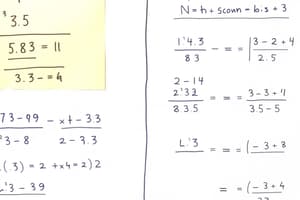Podcast
Questions and Answers
What is a proportional relationship?
What is a proportional relationship?
- A relationship where the ratio of one quantity to the other is constant (correct)
- A relationship that is represented by a straight line on a graph
- A relationship that can be expressed in the form y = mx + b
- A relationship that does not pass through the origin
What defines a non-proportional relationship?
What defines a non-proportional relationship?
- The line passes through the origin
- The relationship is proportional
- There is a constant rate of change
- It can be expressed as y = mx + b where b is not 0 (correct)
What is a rate?
What is a rate?
A ratio of two quantities measured in different units.
What is a unit rate?
What is a unit rate?
What does a linear relationship represent?
What does a linear relationship represent?
What is the constant of proportionality?
What is the constant of proportionality?
What is a proportion?
What is a proportion?
What is a constant?
What is a constant?
What is direct variation?
What is direct variation?
What is the slope?
What is the slope?
What does 'change in y values' refer to?
What does 'change in y values' refer to?
What does 'change in x values' refer to?
What does 'change in x values' refer to?
What is the rate of change?
What is the rate of change?
What does linear mean in mathematics?
What does linear mean in mathematics?
What is the delta symbol for change?
What is the delta symbol for change?
What does Δy / Δx represent?
What does Δy / Δx represent?
What is the origin in a coordinate plane?
What is the origin in a coordinate plane?
What is the y-intercept?
What is the y-intercept?
Flashcards are hidden until you start studying
Study Notes
Proportional Relationships
- Defined as a relationship where the ratio between two quantities remains constant.
- Typically represented by the equation ( y = kx ), where ( k ) is the constant of proportionality.
Non-Proportional Relationships
- Expressed in the form ( y = mx + b ) with ( b \neq 0 ).
- The graph is a straight line that does not intersect the origin.
Rate and Unit Rate
- A rate compares two quantities with different units.
- A unit rate compares to one unit of the second quantity, often expressed as "per".
Linear Relationships
- Changes in the independent variable ( x ) result in equal proportional changes in the dependent variable ( y ).
- Always represented by straight line graphs in the form ( y = mx + b ).
Constant of Proportionality
- The fixed ratio in a proportional relationship typically written as ( y = kx ).
Proportion
- An equation indicating that two ratios are equivalent.
Constants
- Values that remain unchanged in the context of a relationship.
Direct Variation
- Describes how an increase or decrease in one variable proportionally affects another variable, shown as ( y = kx ).
Slope
- Represents the steepness of a line on a graph, calculated as the ratio of the change in ( y ) values to the change in ( x ) values (( \text{slope} = \frac{\Delta y}{\Delta x} )).
Change in Values
- Change in ( y ) values is calculated as ( y_2 - y_1 ).
- Change in ( x ) values is calculated as ( x_2 - x_1 ).
Rate of Change
- The ratio comparing the change in a dependent variable to the change in an independent variable, synonymous with slope.
Linear Function
- A linear relationship or function can be depicted by a straight line on a graph.
Delta Symbol (Δ)
- Represents change or difference, simplifying the description of variations in values.
Coordinate System
- The origin is the point where the x-axis and y-axis meet, located at (0,0).
Y-Intercept
- The coordinate that represents where a graph intersects the y-axis.
Studying That Suits You
Use AI to generate personalized quizzes and flashcards to suit your learning preferences.




